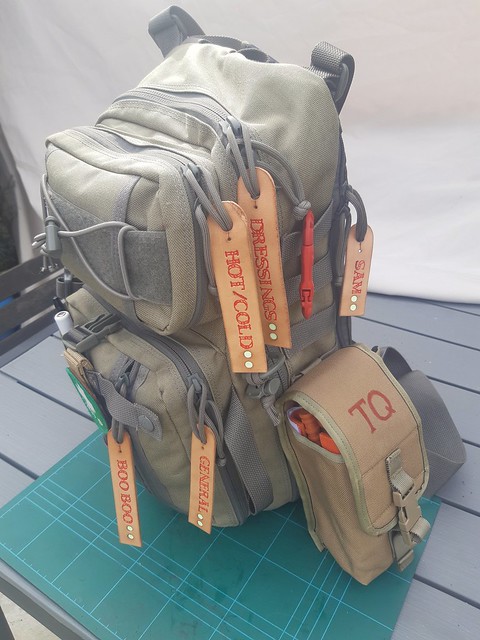I'm always one for constantly reviewing and repacking my kit.....
One of the things that we all carry is a medical kit. The contents of your med kit is generally based on your knowledge of treating injuries, confidence is the use of your med kit, stowage, cost, ease of use..... the list goes on.
A lot of med kits are commercially brought items with generic contents, all packed very nicely, with labelling and nice sterile wrappers, the pouch it comes in is normally bright red (which, incidentally is a very good idea).
We did a little lesson in the house this evening with old medical kits, the scenario being daddy had cut his leg really badly and fell over in the kitchen......
I coached the eldest through it and she did well. The resulting mess was this....

Afterwards, the main learning point for me was the dangerously long amount of time it took to open the med bag, then open a sealed dressing, then getting through another internal sterile wrapping, which led to panic and frustration in my daughter, which impacted on her ability to think clearly and act appropriately.......
So I got to thinking and researching. I looked at the in-house and vehicle med kits with a more critical eye. I took them all apart, taking everything out of the commercial wrappers and repacking each med kit in its own clear vacuum sealed pouch. So now they look like this....


The bag is clear. You can see everything in it. Its vacuum sealed so its compact, waterproof and sealed off from the environment. If you need it, you tear it open and voilà, its all there for immediate use. No mess, no fuss, no having to waste valuable life saving time ripping your trauma bandage out of three layers before you can put it on your loved one/best friend and save their life......
*disclaimer for the Internet*
My med kits are designed to deal with catastrophic bleeds, with the possibility of multiple casualties, by a person with a good degree of training, not for the removal of a thorn in your finger or sort out a headache....
I know that some will say that all that wrapping is to keep each item sterile and prevent infection, but ask yourself this: if you're trapped in your car with a femoral bleed and I rock up with this kind of med kit, rip it open and start applying pressure to your bleed, do you even care about my med kit being 'sterile' or do you care about not dying......(infection control will come later my friend, don't worry).
I am not a medical professional. This is my idea and I thought I would share it. What you do with what you read is your responsibility.
Peace.
Sent from my SM-G970F using Tapatalk
One of the things that we all carry is a medical kit. The contents of your med kit is generally based on your knowledge of treating injuries, confidence is the use of your med kit, stowage, cost, ease of use..... the list goes on.
A lot of med kits are commercially brought items with generic contents, all packed very nicely, with labelling and nice sterile wrappers, the pouch it comes in is normally bright red (which, incidentally is a very good idea).
We did a little lesson in the house this evening with old medical kits, the scenario being daddy had cut his leg really badly and fell over in the kitchen......
I coached the eldest through it and she did well. The resulting mess was this....

Afterwards, the main learning point for me was the dangerously long amount of time it took to open the med bag, then open a sealed dressing, then getting through another internal sterile wrapping, which led to panic and frustration in my daughter, which impacted on her ability to think clearly and act appropriately.......
So I got to thinking and researching. I looked at the in-house and vehicle med kits with a more critical eye. I took them all apart, taking everything out of the commercial wrappers and repacking each med kit in its own clear vacuum sealed pouch. So now they look like this....


The bag is clear. You can see everything in it. Its vacuum sealed so its compact, waterproof and sealed off from the environment. If you need it, you tear it open and voilà, its all there for immediate use. No mess, no fuss, no having to waste valuable life saving time ripping your trauma bandage out of three layers before you can put it on your loved one/best friend and save their life......
*disclaimer for the Internet*
My med kits are designed to deal with catastrophic bleeds, with the possibility of multiple casualties, by a person with a good degree of training, not for the removal of a thorn in your finger or sort out a headache....
I know that some will say that all that wrapping is to keep each item sterile and prevent infection, but ask yourself this: if you're trapped in your car with a femoral bleed and I rock up with this kind of med kit, rip it open and start applying pressure to your bleed, do you even care about my med kit being 'sterile' or do you care about not dying......(infection control will come later my friend, don't worry).
I am not a medical professional. This is my idea and I thought I would share it. What you do with what you read is your responsibility.
Peace.

Sent from my SM-G970F using Tapatalk
Last edited:

 2020-07-18_05-21-39
2020-07-18_05-21-39